Recent Posts
Emergency Response Planning for Storms: Creating a Checklist
1/4/2024 (Permalink)
Living in South Central regions often comes with the risk of severe storms, including hurricanes, tornadoes, and heavy thunderstorms. Having a well-prepared emergency response plan is crucial for ensuring the safety of yourself, your loved ones, and your property during these hazardous weather events. In this blog, we will discuss the essential elements of creating an emergency response checklist specifically tailored for South Central storms, including preparedness, communication, shelter, and post-storm actions.
Preparedness
- Stay informed about storm forecasts by regularly monitoring local weather reports, official meteorological sources, and emergency management agencies.
- Gather essential emergency supplies, including non-perishable food, water, batteries, flashlights, a first aid kit, and medication, and keep them easily accessible.
- Create a family emergency plan that outlines meeting points, emergency contacts, and evacuation procedures. Review and practice this plan with your family members regularly.
Communication
- Have multiple communication methods available, including cell phones, landlines, and battery-powered radios, along with spare chargers.
- Designate an out-of-town emergency contact person that family members can reach to provide updates or coordinate reunification efforts.
- Utilize local emergency alert systems, such as text alerts and smartphone apps, to stay informed about evacuation orders, severe weather warnings, and post-storm updates.
Shelter
- Identify safe shelter locations in and around your home, such as a basement, storm cellar, or interior room without windows. Reinforce these areas if necessary.
- Familiarize yourself with community storm shelters, evacuation routes, and designated meeting points in case you need to seek refuge outside of your home.
- If ordered to evacuate, follow the instructions of local authorities and have a designated evacuation plan in place, including a pre-determined destination and necessary supplies.
Post-Storm Actions
- Exercise caution when venturing outside after a storm, as dangers may still be present, such as downed power lines, fallen trees, and floodwaters.
- Document any damage to your property by taking photographs or videos to assist with insurance claims.
- Report any emergency situations, such as gas leaks or downed power lines, to the appropriate authorities immediately.
- Check on the well-being of neighbors, particularly those who may require assistance, such as the elderly, disabled, or individuals with medical conditions.
Insurance and Documentation
- Review your insurance policy to ensure you are adequately covered for storm-related damages, and keep your policy information easily accessible.
- Keep important documents, such as identification, insurance policies, birth certificates, and medical records, in a secure and waterproof container.
- Consider storing digital copies of important documents and records on cloud storage or a portable drive for easy access during and after the storm.
Creating an emergency response checklist specific to South Central storms is essential for protecting yourself, your loved ones, and your property. By prioritizing preparedness, maintaining effective communication, identifying safe shelter locations, knowing post-storm actions, and documenting important information, you can navigate through storm events with confidence and ensure a swift recovery. Review and update your checklist regularly to stay prepared for South Central storms and enhance your overall emergency response capabilities.
Restoring Fire-Damaged Artwork and Collectibles: Tips and Techniques
11/28/2023 (Permalink)
Experiencing a fire can be devastating, especially for art collectors and enthusiasts who have precious pieces of artwork and collectibles that have been damaged by fire. Restoring fire-damaged artwork requires a unique set of skills and techniques to ensure that the items are restored without causing further damage. In this blog, we explore tips and techniques for restoring fire-damaged artwork and collectibles.
Assessing the Damage
The first step to restoring fire-damaged artwork is to assess the extent of the damage.
Careful evaluation by experts is necessary to determine the specific restoration needs and to prevent further damage.
Cleaning Techniques
Cleaning techniques for fire-damaged artwork depend on the type of material and the extent of damage. Dust, soot, and other residues can be removed using a soft-bristled brush or a vacuum with a HEPA filter.
Dealing with Smoke Damage
Smoke damage is a severe issue with fire-damaged artwork. The affected item may require specialized cleaning methods to remove smoke stains and odors.
Restoring Paintings
Restoring paintings requires unique skills and techniques to repair smoke damage, cracks, and tears. An expert conservator can stabilize the painting, clean the surface, and retouch areas damaged by the fire.
Restoring Sculptures
Sculptures require cleaning, consolidation, and stabilization after fire damage. If the piece has cracks or chips, a conservator may use fillers such as epoxy or polyester resins to repair the damage.
Restoring Collectibles
Precious collectibles also require specialized care after fire damage. Some items may require restoration work, such as reattachment of detached pieces, cleaning of stains or smoke damage, and repainting.
Importance of Professional Restoration
Restoring fire-damaged artwork and collectibles is an intricate process that requires specialized knowledge and skills. Attempting to clean or repair damaged pieces without proper training or equipment can cause further damage to the item.
Restoring fire-damaged artwork and collectibles requires a careful assessment of the damage, appropriate cleaning techniques, and specialized restoration skills. Art conservators and restoration experts have the necessary expertise to restore precious pieces damaged by fire safely. It's important to seek their help for restoring damaged artwork and collectibles. By following the tips and techniques mentioned in this blog, art collectors can take the necessary steps towards restoring their beloved items and preserving their beauty.
Common Causes of Mold Growth in Homes: Understanding and Addressing the Issue
10/26/2023 (Permalink)
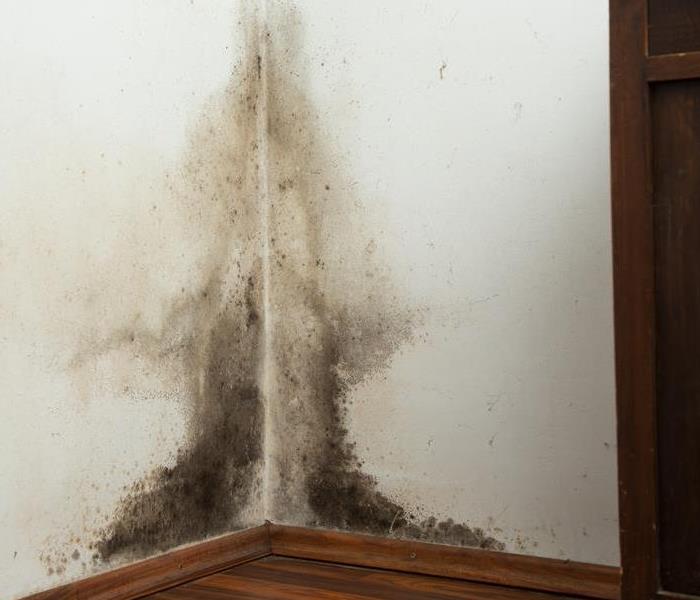 By understanding mold and common cause, protect your home with the right precautions and preventative measures.
By understanding mold and common cause, protect your home with the right precautions and preventative measures.
Mold growth is a common problem faced by homeowners, and understanding its causes is crucial for effective prevention and management. In this blog, we will explore the common causes of mold growth in homes. By identifying these underlying factors, you can take proactive measures to address them, ensuring a mold-free living environment for you and your family.
Moisture Build-Up
Excess moisture is the primary catalyst for mold growth in homes. Improper ventilation, condensation, or leaks from plumbing, roofs, or foundations can create an environment conducive to mold development. Areas with high humidity, such as bathrooms or kitchens, are particularly susceptible. Regularly inspecting and addressing potential sources of moisture build-up is essential to prevent mold growth and potential damage to your home.
Plumbing Leaks
Leaky pipes or faucets provide a consistent source of moisture that can promote mold growth. Small, undetected leaks can occur behind walls or under sinks, creating a hidden breeding ground for mold. Regularly check for signs of water damage, such as water stains or wet spots, and promptly fix any plumbing leaks or issues to eliminate moisture and reduce the risk of mold infestation.
Poor Ventilation
Inadequate ventilation can contribute to moisture accumulation, creating an environment ideal for mold growth. Rooms with limited airflow, such as basements, attics, or bathrooms, are particularly prone to mold infestation. Ensure proper ventilation by using exhaust fans, opening windows, or installing air vents. By improving airflow and reducing humidity levels, you can effectively prevent mold growth in these areas.
Flooding and Water Intrusion
Flooding or water intrusion from heavy rainfall, burst pipes, or roof leaks can quickly create a moisture problem in homes. If not promptly addressed, these situations can lead to significant mold growth. It's crucial to address and repair any water damage immediately and thoroughly dry affected areas. This will prevent excessive moisture buildup and mitigate the risk of mold infestation in the aftermath of such events.
Dampness in Basements and Crawl Spaces
Basements and crawl spaces are prone to high humidity levels and moisture buildup due to their proximity to the ground. The lack of sunlight and proper ventilation further contribute to the likelihood of mold growth in these areas. Regularly inspecting and maintaining basements and crawl spaces, ensuring proper drainage, and using dehumidifiers can help prevent mold infestation and protect the integrity of your home's foundation.
Poor Maintenance and Neglect
Neglecting regular maintenance and upkeep of your home can contribute to mold growth. Ignoring minor water leaks, failing to clean and dry wet areas promptly, and neglecting routine inspections can create an environment prone to mold infestation. By practicing good maintenance habits, such as regularly checking for leaks, promptly addressing any water damage, and keeping your home clean and well-ventilated, you can prevent mold growth and maintain a healthy living space. Taking proactive steps to maintain your home's condition is key to avoiding mold-related issues.
By understanding the common causes of mold growth in your home and with research you can take proactive measures to prevent mold infestation. Regular maintenance, prompt repairs of leaks, adequate ventilation, and effective moisture control are vital in creating a mold-free living environment. By addressing these underlying causes, you can ensure the long-term protection and well-being of your home and loved ones.
Common Mistakes Homeowners Make That Lead to Water Damage
10/18/2023 (Permalink)
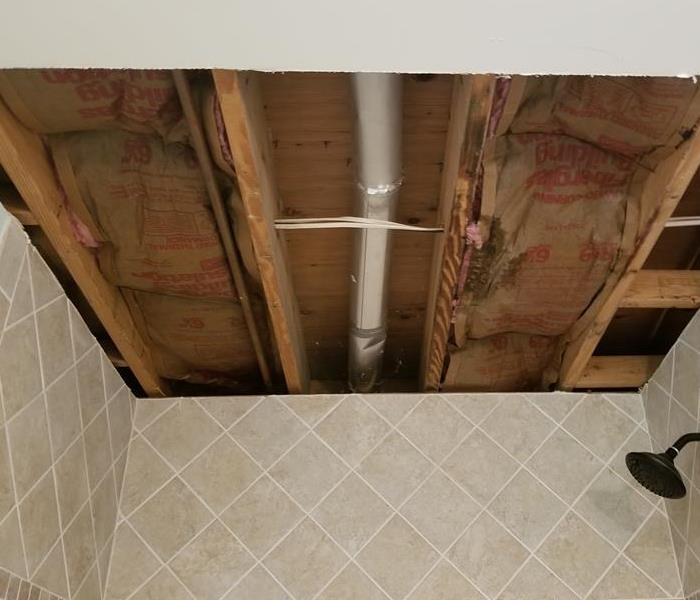 Address water damage issues quickly to prevent further damage to your home.
Address water damage issues quickly to prevent further damage to your home.
Water damage can be a homeowner's worst nightmare. It can wreak havoc on your property, cause costly repairs, and even lead to hazards like mold growth. While some water damage incidents are unavoidable, many are the result of common mistakes made by homeowners. In this blog post, we'll highlight some of the most common mistakes homeowners make that can lead to water damage, and provide tips on how to avoid them.
1. Ignoring Plumbing Maintenance
One of the biggest mistakes homeowners make is ignoring regular plumbing maintenance. Over time, pipes can deteriorate, develop leaks, or become clogged, leading to water damage. To avoid this, schedule regular inspections of your plumbing system. Look for signs of leaks, such as damp spots, water stains, or an increase in your water bill. Address any plumbing issues promptly and replace old or corroded pipes to prevent potential water damage.
2. Neglecting Roof Maintenance
Your roof is your home's first line of defense against water damage, so neglecting its maintenance can lead to serious issues. Many homeowners forget to inspect their roof regularly for damaged or missing shingles, deteriorated flashing, or clogged gutters. These problems can cause water to seep into your home, leading to leaks and interior damage. Regularly inspect your roof, clean your gutters, and make necessary repairs to keep your home protected.
3. Not Properly Sealing Windows and Doors
Improperly sealed windows and doors can allow water to infiltrate your home during heavy rainstorms or in areas prone to high humidity. Check for gaps or cracks around your windows and doors, and apply weatherstripping or caulk to seal them properly. This simple step can prevent water from seeping in and causing damage to your home's interiors.
4. Neglecting Your Sump Pump Maintenance
If your home has a sump pump, neglecting its maintenance can be a recipe for disaster. Sump pumps are designed to prevent basement flooding by pumping out excess water. However, if the pump fails or gets clogged, your basement can quickly turn into a waterlogged mess. Regularly inspect your sump pump, clean it out, and test it to ensure it's in proper working order. Consider installing a battery backup system as well, in case of power outages during heavy storms.
5. Overwatering Landscaping
While having a beautiful garden or a well-maintained lawn is something many homeowners strive for, overwatering can lead to water damage. Excessive watering can cause water to pool against the foundation of your home, leading to basement leaks or foundation issues. Be mindful of the amount of water you use for landscaping and ensure proper drainage away from your home's foundation.
6. Not Taking Prompt Action After a Water Leak
Perhaps one of the biggest mistakes homeowners make is not taking prompt action when a water leak occurs. Whether it's a burst pipe, a malfunctioning appliance, or a roof leak, immediate action is crucial to minimize damage. Shut off the water source, address the leak, and dry out any affected areas as soon as possible. Mold can start growing within 24-48 hours, so quick action is essential to prevent further damage and potential health hazards.
By avoiding these common mistakes, homeowners can significantly reduce the risk of water damage to their homes. Regular maintenance, prompt action, and being proactive in preventing water intrusion can save homeowners time, money, and the stress of dealing with water damage. Remember, prevention is key, so invest time in maintaining your home's plumbing, roof, and seals, and always address any issues promptly to protect your property from potentially devastating water damage.
Dealing with Water Damage After a Storm
9/28/2023 (Permalink)
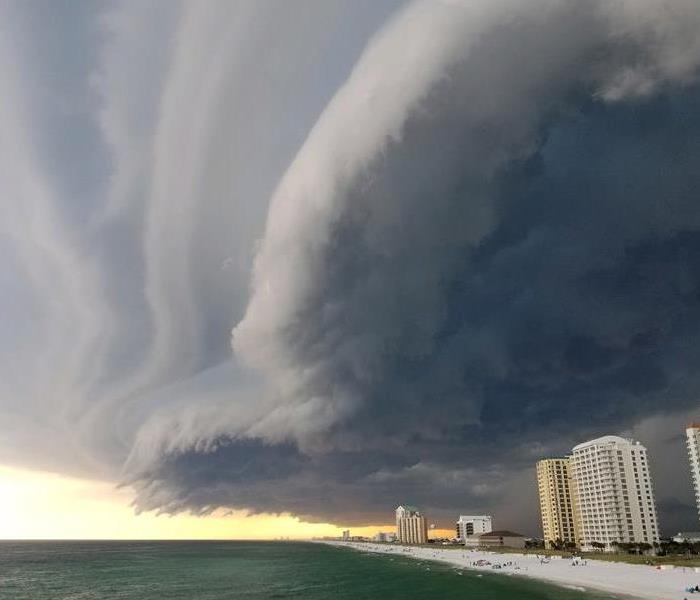 Water damage can be a challenge after a storm. Contact a professional to help mitigate water and storm damage.
Water damage can be a challenge after a storm. Contact a professional to help mitigate water and storm damage.
Water damage can be a widespread problem after any storm, and it can be particularly devastating for property owners in the South Central region. Storms in this region can bring heavy rainfall, flash floods, and other water-related catastrophes that can ruin your home or business. In this blog post, we will discuss the steps you can take to deal with water damage after a storm in the South Central region.
Ensure Safety First
Before you begin any water damage repair efforts, ensure that you and your family are safe. Be aware that water can carry dangerous chemicals and bacteria that can pose a health risk. Wear protective gear, such as gloves, masks, and boots. Also, be particularly cautious when using any electrical equipment near water, and do not use any electrical devices until you are sure that it's safe to do so.
Take photos or videos of the water damage to document the extent of the damage. This will help your insurance company assess your claim accurately. Take inventory of any damaged possessions, furniture, carpets, and other items, and make a list of them. Include any receipts or other proof of purchase for your items.
Remove Standing Water
Standing water is a breeding ground for mold and other harmful microorganisms that can worsen the damage. Your first step in dealing with water damage should be to remove as much standing water from your property as possible. You can use a pump, mop, or bucket to remove water, then use a dehumidifier or fans to assist with drying any remaining moisture.
After you've removed standing water, your next step should be to dry all wet materials thoroughly. This includes your walls, floors, carpets, and any other furniture or items that were affected. Use fans, dehumidifiers, and open windows to allow air to circulate and dry out damp environments.
Check for Mold
Mold can begin to form within as little as 24 hours after the flooding. Thus, it's important to check for mold growth thoroughly. Check confined areas, like attics, basements, and crawl spaces, as well as areas exposed to water, such as carpets, walls, and ceilings. If you have any concerns, call a professional mold removal company to evaluate it.
Water damage can weaken the structural integrity of your property over time. If you notice any structural damage, it's crucial to address the issue as soon as possible. Check walls, floors, roof, and the foundation for any cracks, warping, or other indications of structural defects. Professional contractors can help evaluate and repair any damage found.
Seek Professional Assistance
Dealing with water damage can be a daunting task. If you are overwhelmed, consider seeking assistance from a professional water damage restoration company. An expert team can help with assessing the damage, developing a repair plan, and carrying out a proper repair process. They have the expertise and specialized equipment required to repair damage quickly and effectively.
Water damage can be a significant challenge after the storm, but dealing with it properly is essential to restore your property to its pre-storm condition. It is imperative to take safety measures, document the damage, remove standing water, dry wet materials, check for mold, address structural damage, and seek professional assistance. The sooner you address water damage, the better. Quick action will minimize expensive repairs and health risks, preventing further deterioration of your property.
Why Your Fire Alarm is Trying to Get Your Attention
8/19/2023 (Permalink)
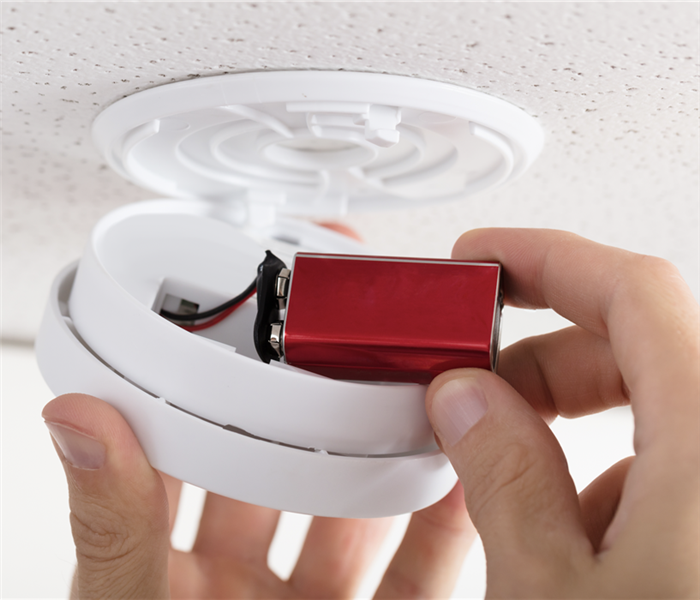 Your fire alarm is a lifeline between you and your family's safety.
Your fire alarm is a lifeline between you and your family's safety.
As a responsible homeowner or property owner, ensuring the safety of your loved ones and assets is a top priority. Your fire alarm plays a crucial role in safeguarding your home against potential fire hazards. When your fire alarm beeps, it's not just making noise; it's attempting to convey a vital message. Ignoring the beeping could have serious consequences. In this blog, we'll delve into the reasons behind fire alarm beeping and the importance of addressing these alerts promptly. Let's explore the various scenarios and understand why you should never ignore the beep.
Low Battery Warning
One of the most common reasons for fire alarm beeping is a low battery. When the battery in your fire alarm nears the end of its life, it will emit intermittent beeps to alert you to replace it. Ignoring this warning can leave your home vulnerable in case of a fire emergency. Always respond promptly by replacing the battery to maintain your fire alarm's effectiveness.
Sensor Malfunction
Fire alarms are equipped with sensitive sensors designed to detect smoke or heat. If a sensor malfunctions, it can trigger false alarms or constant beeping. Never overlook such occurrences, as it might indicate a potential issue with the sensor's functionality. Contact a professional to inspect and repair the fire alarm promptly.
Smoke or Dust Buildup
Dust and debris accumulation within the fire alarm can interfere with its sensors, leading to false alarms or continuous beeping. Regularly clean your fire alarm to keep it free from dust and maintain its efficiency. Avoid using water or liquid cleaners, as they may damage the unit. A gentle vacuuming or wiping with a dry cloth should suffice.
Expired Fire Alarm
Fire alarms have a limited lifespan, typically ranging from 8 to 10 years. If your fire alarm is reaching the end of its useful life, it may beep to notify you that it requires replacement. Never ignore this signal, as an outdated fire alarm may not provide reliable protection in case of a fire.
Electrical Issues
Sometimes, the beeping could be due to electrical problems, such as power surges or faulty wiring. Electrical issues may disrupt the fire alarm's proper functioning, jeopardizing your safety. If the beeping persists despite addressing other potential causes, consult an electrician to investigate and resolve any electrical problems.
Your fire alarm is a lifeline between you and your family's safety. When it beeps, it's speaking to you, and ignoring its message is not an option. Regular maintenance, timely battery replacement, and swift action to address any issues are vital to ensure your fire alarm's effectiveness. Remember, a properly functioning fire alarm can make all the difference in protecting your home and loved ones during a fire emergency. Take the beeping seriously and act promptly to maintain a secure and well-protected home.
Storm Preparedness: How to Keep Water Out of Your Building and Prevent Costly Water Damage
6/15/2023 (Permalink)
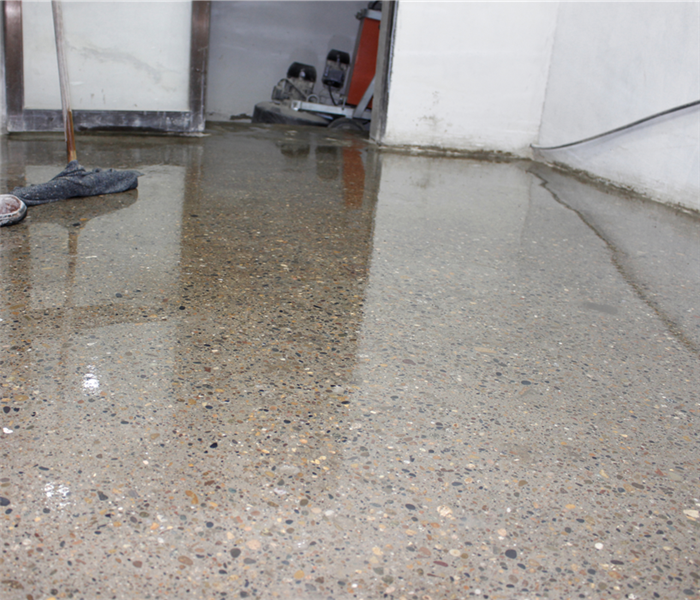 If your building does experience water damage, it's important to act quickly.
If your building does experience water damage, it's important to act quickly.
Storms can bring about a lot of damage, especially to buildings that are not prepared for heavy rain or flooding. Water damage can be very costly to repair, and it's important to take preventative measures to avoid it. Here are some tips on how to keep water out of your building during or after a storm.
Check Your Roof
The roof is the first line of defense against water damage. If your roof is old or damaged, it can easily leak during a storm. Check your roof for missing or damaged shingles, cracks, and other signs of wear and tear. Make sure your gutters are clear of debris and are functioning properly, so water can flow away from your building.
Seal Any Cracks or Gaps
Water can seep in through even the smallest of cracks and gaps. Check your building for any openings around windows, doors, and walls, and seal them up. Use caulk, weatherstripping, or sealant to keep water out.
Invest in Sandbags
If your building is in a flood-prone area, consider investing in sandbags. Sandbags can be stacked around your building to create a barrier against floodwaters. Be sure to place them around any doors or windows to prevent water from entering.
Install a Sump Pump
A sump pump is a device that is used to remove water that has accumulated in a basement or crawl space. It is typically installed in a pit or well that is dug in the lowest part of the basement or crawl space. A sump pump will automatically turn on and pump water out of your building when the water level rises.
Elevate Your Appliances
If you have appliances in your basement or on a lower level, elevate them off the ground. This will help prevent them from getting damaged in the event of a flood. You can use cinder blocks or other sturdy materials to raise them off the ground.
Monitor Weather Reports
Keep an eye on weather reports and take action if a storm is expected to hit your area. Move valuable items to higher ground or away from windows, and make sure your sump pump is working properly.
By taking these steps, you can help prevent water damage to your building during or after a storm. However, if your building does experience water damage, it's important to act quickly. Contact a professional restoration company like SERVPRO to mitigate the damage and restore your building as quickly as possible.
5 Items You Should Throw Out After Mold Exposure in Your Home
5/16/2023 (Permalink)
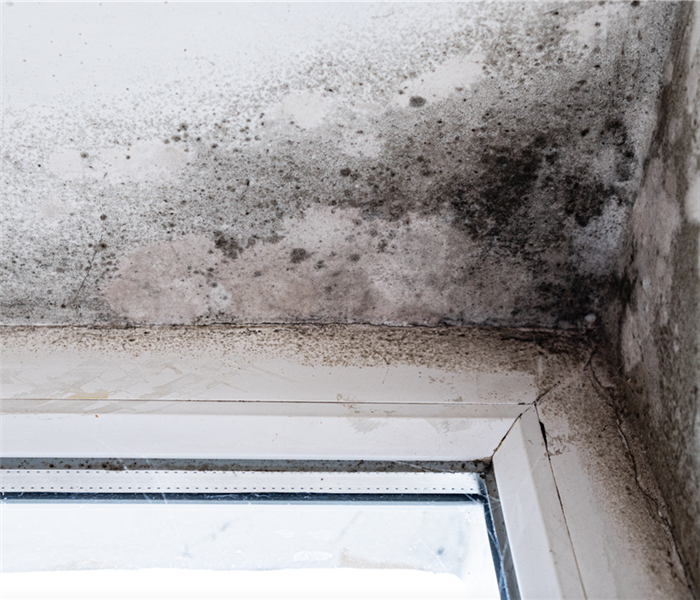 If you're unsure how to handle mold exposure in your home, contact our SERVPRO of Downtown Houston team for help.
If you're unsure how to handle mold exposure in your home, contact our SERVPRO of Downtown Houston team for help.
Mold is a type of fungus that can grow in damp and humid areas of your home. If you've recently had mold in your home, you may be wondering what items you should throw out. In this blog post, we'll share some tips on what to throw out after mold exposure.
Porous materials
Porous materials are those that can absorb water, such as wood, paper, and fabrics. If these materials have been exposed to mold, it can be difficult to remove the mold completely. In many cases, it's best to throw out these items, as mold can continue to grow even after cleaning. This includes items such as clothing, curtains, and upholstered furniture.
Cardboard and paper
Cardboard and paper are also porous materials that can absorb moisture and promote mold growth. If you have any cardboard boxes or paper items that have been exposed to mold, it's best to throw them out. This can include items such as books, magazines, and paper documents.
Food and drink
Mold can grow on food and drink, making it unsafe to consume. If you have any food or drink that has been exposed to mold, it's best to throw it out. This includes items such as bread, fruits, vegetables, and dairy products. It's important to be especially careful with items that are difficult to clean, such as sponges and kitchen utensils.
Non-porous materials
Non-porous materials are those that do not absorb water, such as metal, glass, and plastic. These materials are less likely to promote mold growth, but they can still become contaminated if exposed to mold. In many cases, non-porous items can be cleaned and salvaged after mold exposure. This includes items such as dishes, appliances, and hard furniture.
Electronics
Electronics are another item that can be affected by mold exposure. If you have any electronic items that have been exposed to mold, it's important to take precautions when handling them. Do not turn on the device until it has been thoroughly cleaned and inspected by a professional. In many cases, electronics can be salvaged after mold exposure, but it's important to take precautions to prevent further damage.
Act Fast: What to Do After Mold Exposure in Your Home
In conclusion, when it comes to mold exposure, it's important to take action quickly to prevent further contamination. Porous materials such as clothing and paper should be thrown out, while non-porous items can often be salvaged with proper cleaning. Food and drink should also be discarded if they have been exposed to mold. If you have any doubts about an item, it's best to err on the side of caution and throw it out. If you're unsure how to handle mold exposure in your home, contact a disaster restoration company, such as SERVPRO of Downtown Houston, for help.
We Are Your Partners Against Commercial Property Damage | SERVPRO® of Downtown Houston Central South
5/8/2023 (Permalink)
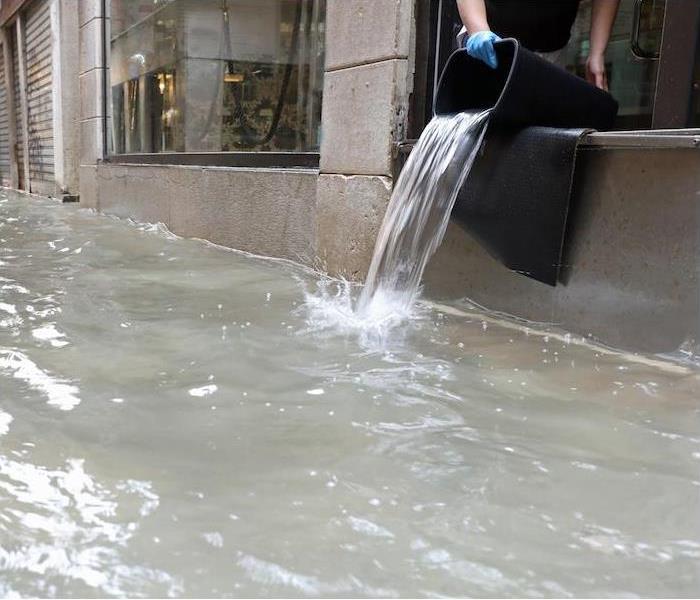 Protect your business from unnecessary water damage -- call SERVPRO of Downtown Houston Central South at the first sign of water in your business.
Protect your business from unnecessary water damage -- call SERVPRO of Downtown Houston Central South at the first sign of water in your business.
We know what it takes to run a successful business, which means that chances are you are probably really busy. From setting schedules to updating inventory and managing workflow, sometimes it can feel like there is not enough time in the day!
The fruits of your labor will pay off in time, but that doesn’t mean you have to do everything yourself right now. SERVPRO of Downtown Houston Central South is here to work alongside you to ensure you have everything you need to be successful.
Our team can help restore your property after a disaster, and we can even help keep it clean so you can focus on other aspects of your business. We explain more of this in detail below, so check it out!
Our Restoration Services
Suffering a disaster at work can be a shock to you as well as to your employees. Flooded warehouses, storm damage and even something as scary as a chemical fire can cause widespread damage and a lot of questions from your crew.
Our job is to arrive quickly and work efficiently in order to minimize downtime and keep closures to a minimum.
Our restoration team includes an elite team of technicians who are trained in large-loss recovery, and we know how to handle each situation. We can work with hospitals, universities, government facilities and even stadiums. We have a project manager who oversees the process, and our team members are trained to notice and restore every detail possible.
Our Cleaning Services
We would bet that you didn’t open your business just because you love to spend your time cleaning, so let us handle that important aspect of your business for you. We can come out to your building regularly for general deep cleanings or we can assist you in more deep-cleaning needs, such as cleaning your carpets or removing a stubborn odor from your storefront.
We also have a biohazard team on staff that is trained to handle biohazard materials safely and efficiently. If an accident happens and you need help with a bloodborne pathogen situation or a trauma occurs at your site, our biohazard team has the competence and care to help you completely recover.
Reducing Your Losses
The best offense is a good defense when it comes to reducing your risk of large-scale damages. In order to do that, our SERVPRO team can help you create an Emergency Ready Plan that can help you respond faster and more efficiently to a developing situation.
It is a complete guide that will take you through the process from start to finish, including details like where your shut-off valves are, an outline of who is in charge of what and a step-by-step guide that will help you through a smoother insurance claims process. Let our team help you prepare for and prevent disaster at your business.
Are you dealing with damage to your commercial property? SERVPRO of Downtown Houston Central South can help.
Fire Extinguishers 101: How to Choose the Right One for Your Home or Business
4/15/2023 (Permalink)
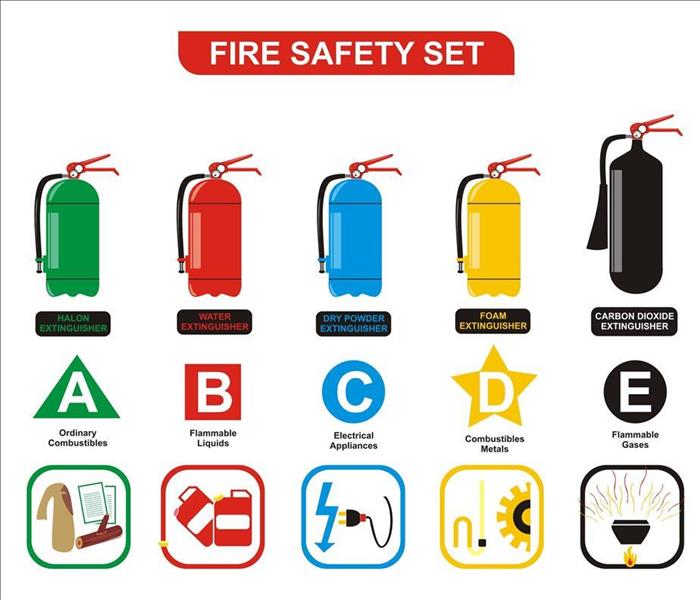 There are five main types of fire extinguishers.
There are five main types of fire extinguishers.
Fire extinguishers are an essential tool to have in any home or business to protect against unexpected fires. But with so many different types of fire extinguishers on the market, it can be overwhelming to determine which one is right for your specific needs. In this blog, we will discuss the different types of fire extinguishers available and provide tips on how to choose the right one for your home or business.
Types of Fire Extinguishers
There are five main types of fire extinguishers, each designed to put out specific types of fires:
- Class A: This type of fire extinguisher is designed to put out fires that involve ordinary combustibles such as wood, paper, and cloth.
- Class B: This type of fire extinguisher is designed to put out fires that involve flammable liquids such as gasoline, oil, and grease.
- Class C: This type of fire extinguisher is designed to put out fires that involve electrical equipment such as appliances, computers, and power tools.
- Class D: This type of fire extinguisher is designed to put out fires that involve flammable metals such as magnesium, titanium, and sodium.
- Class K: This type of fire extinguisher is designed to put out fires that involve cooking oils and fats commonly found in commercial kitchens.
How to Choose the Right Fire Extinguisher
When choosing a fire extinguisher, it's important to consider the type of fire you may encounter. For example, if you have a commercial kitchen, a Class K fire extinguisher would be the best choice. If you have a workshop with welding equipment, a Class D fire extinguisher would be the best choice. If you have a home with a fireplace, a Class A fire extinguisher would be the best choice.
It's also important to consider the size and weight of the fire extinguisher. A larger fire extinguisher will be able to put out a fire for a longer period of time but may be too heavy to handle for some individuals. A smaller fire extinguisher may be easier to handle, but may not have enough extinguishing agents to put out a larger fire.
In addition, it's important to ensure that the fire extinguisher is easily accessible and visible in case of an emergency. It's recommended to have at least one fire extinguisher on each floor of your home or business and to have them located near exits and high-risk areas such as kitchens and workshops.
Lastly, it's important to ensure that your fire extinguisher is properly maintained and serviced. This includes checking the pressure gauge regularly and having the fire extinguisher serviced and recharged as needed.
Fire extinguishers are an important tool to have in any home or business to protect against unexpected fires. By understanding the different types of fire extinguishers and choosing the right one for your specific needs, you can help ensure the safety of yourself and those around you. Remember to properly maintain and service your fire extinguisher to ensure it's ready to use in case of an emergency.

 24/7 Emergency Service
24/7 Emergency Service







